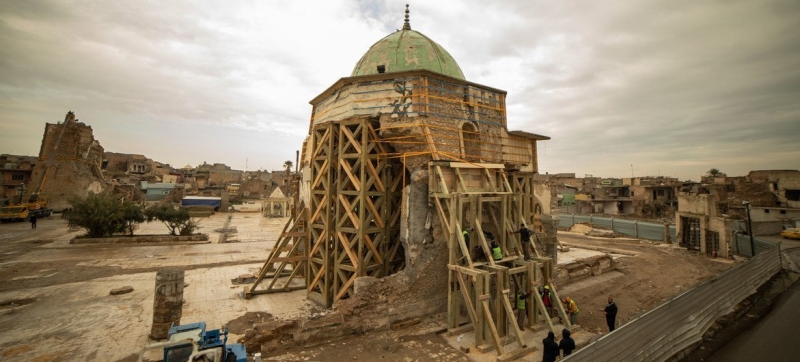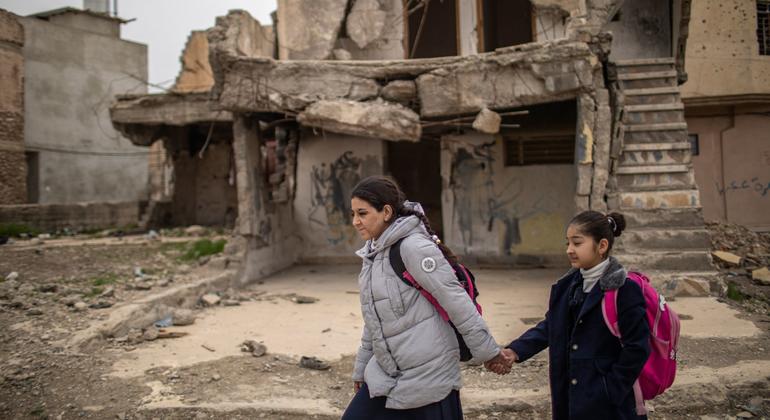
The al-Nuri Mosque was severely damaged by an explosion during the Battle of Mosul in 2017. Reviving Mosul: A Heritage Restored Through International Cooperation Culture and Education
A year after the black flags of ISIS were lowered over Mosul, UNESCO launched an ambitious initiative to help the city rise from the ashes. Today, “Reviving the Spirit of Mosul” is a story of hope and resilience. It has also demonstrated how effective international cooperation can be.
Reviving Iconic Landmarks ‘In Their Original Form’
In 2014, after the ISIS invasion of Mosul, the al-Nuri Mosque and its famous al-Hadba Minaret, which had been symbols of the city for centuries, were left in ruins. Today, however, these cultural monuments once again rise above the skyline. Omar, a young architect and one of the locals carefully recreating fragments of history, says: “When the minaret rose above the skyline again, it was as if my city had come back to life.”
Reconstruction is not just a physical restoration, it is a restoration of identity and unity. This belief is at the core of UNESCO’s efforts to restore the monuments of Mosul.
The Al-Hadba Minaret during and after reconstruction
The project, launched in partnership with the United Arab Emirates, faced many challenges, from defusing hidden explosives to preserving the 12th-century prayer rooms discovered during excavations, not to mention the need to restore the iconic minaret “as it was,” tilted and using the same materials. Nevertheless, the team persevered, merging history and modernity to create a structure that honored the past and looked to the future.
This approach has been applied to other monuments in the Old City as well. Nearby, the bells of the As-Saa’a Monastery and the At-Tahera Church, brought to Mosul from France and Italy, are ringing once again. Their restoration, with the support of the UAE and the ALIF Foundation, symbolizes the religious diversity that underpins this multi-ethnic community.
Reviving the City’s Cultural Rhythm
In addition to restoring the monuments, it was also important to revive Mosul’s cultural life. The city’s historic neighbourhoods, once filled with laughter and music, are returning to their former rhythm.
To support the return of families to Mosul, UNESCO has painstakingly restored 124 historic houses with support from the European Union. For Najat, who once shared her home with nine siblings, “coming back to live here is like a dream, every corner holds precious memories.”
UNESCO is also implementing cultural initiatives. Young filmmakers trained by the Ghent City Theatre are making documentaries about the reconstruction of Mosul. And young artists now have their own space, the “Station,” where they take lessons on playing traditional musical instruments.

Education: Laying the Foundation for future
In a city where many children have never heard of a classroom due to the conflict, education development has become another cornerstone of hope. Al-Ekhlas Primary School, rehabilitated by UNESCO with EU support, not only has traditional classrooms but also a library and art spaces. Around 400 more classrooms have been renovated in Nineveh governorate, while the University of Mosul has refurbished its library and opened a film department.
To prevent the return of violent extremism, more than 5,000 teachers and parents have been trained in peace education. They have learned how to engage in dialogue with young people who are out of school, identify those suffering from mental health issues, and answer sensitive questions about the events that have occurred.
UNESCO’s vocational training programmes have also been a lifeline for thousands of unemployed young people. Ghufran, a young woman who lost her home during the conflict, was trained in bricklaying. She quickly found work on a local project and used the money she earned to rebuild her home and support her younger siblings.
Reviving a City
Through its comprehensive efforts, UNESCO has not just restored the buildings of Mosul, it has revived the spirit of the city and its people. Mosul is no longer a place rebuilding after a war. It has become a testament to the power of collective action and international mobilization. From the leaning minaret to the laughter of children, this city is alive again.
“Today, Mosul is once again becoming the beacon of hope it should never have ceased to be, an example of how a city can be rebuilt through the power of culture and education, in Iraq and elsewhere,” said UNESCO Director-General Audrey Azoulay.
As Omar emphasized, “we are not just rebuilding Mosul, we are reviving our spirit, and that is something that no one can destroy.” Much remains to be done, but thanks to UNESCO’s initiative, the Old City of Mosul is once again living up to its name: al-mawsil in Arabic means the link or the bridge.
